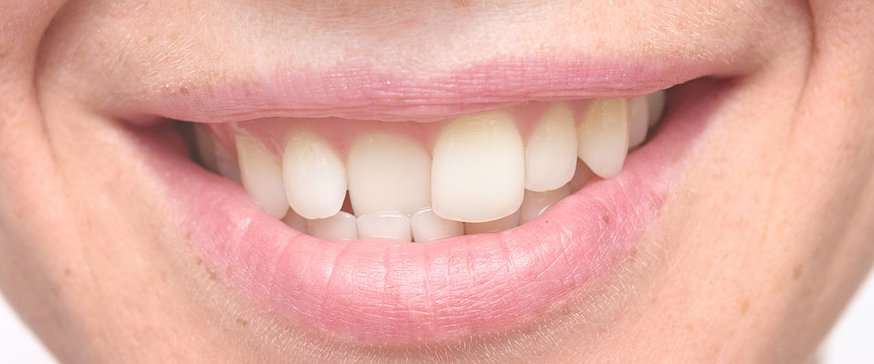
Can You Fix Crooked Teeth with Dental Implants?
Implants don’t straighten teeth; they replace teeth.
If a tooth is healthy but out of line, we move it (Invisalign® or braces) or camouflage it (bonding or veneers). If a tooth can’t be saved—or it’s already missing—an implant replaces it, and the new crown can be positioned so your smile looks straight.
What “crooked teeth” means (in real life)
Crooked can be a twist, overlap, tooth sticking out, tooth tucked in, or a front tooth that sits a little off. You notice it most in photos, especially in the front.
Common reasons
- Jaw size vs tooth size mismatch (crowding or spacing)
- Early baby-tooth loss or adult teeth that never fully came in
- Habits (thumb sucking, tongue thrusting)
- Gum disease and bone loss (teeth drift)
- Traumas and chips that changed how teeth meet
- Bite patterns (crossbite, deep bite, open bite)
What each option can—and can’t—do
- Dental implants: replace a missing or non-restorable tooth with a titanium root and crown. They don’t move other teeth.
- Invisalign® / braces: move teeth into better positions, improve the bite, protect enamel and joints.
- Bonding / veneers: reshape and colour-correct; good for slight crookedness when the bite is otherwise stable.
Often the best result is a combination: align first, fine-tune with bonding or veneers, and replace any tooth that can’t be saved with an implant.
Table 1 — Your situation → sensible first step
|
Situation you describe |
First step that usually makes sense |
Why we start here |
|
Slightly crooked front teeth (small overlaps/rotations) |
Invisalign® or bonding/veneers |
Aligners are discreet; small cosmetic tweaks finish the edges |
|
Crooked + gaps |
Invisalign® → optional bonding for shape |
Closes spacing predictably; bonding refines symmetry |
|
Very crooked / bite feels “off” |
Braces or advanced Invisalign® |
You need real tooth movement for comfort and long-term stability |
|
One front tooth is crooked and cracked/dark |
Assess if saveable → if not, implant |
A crown on an implant can be placed in the ideal line |
|
Crooked with gum problems |
Treat gums first → then align |
Healthy foundation before any movement or replacement |
|
Missing tooth + crowding nearby |
Invisalign® to open ideal space → implant |
The implant sits exactly where the smile needs it |
“How to fix crooked teeth without braces”
- Invisalign®: clear trays for mild–moderate crowding, rotations, and spacing.
- Cosmetic bonding: tooth-coloured resin to mask small twists or close little gaps.
- Porcelain veneers: re-shape edges and correct colour when alignment needs are minor.
- Small enamel reshaping: tiny contouring to even things out (only when safe).
These don’t replace full orthodontics for bigger movements or significant bite problems.

Can Invisalign fix crooked teeth?
Most of the time for mild to moderate cases—yes. For complex crowding or bite correction, we’ll discuss braces or a hybrid plan. We can show a digital preview so you know what to expect.
When implants are actually the right answer
Choose an implant when the tooth is:
Missing
Split or cracked to the root
Too decayed to fix predictably
Loose from advanced gum disease and not saveable
Here, replacing the tooth makes more sense than trying to move or mask it. We plan the implant so the final crown sits in the correct line with your other teeth. Depending on bone and gum health, this may be same-day or staged over a few months. You won’t be left without a presentable tooth in between.
Table 2 — Implants vs Invisalign® vs Veneers/Bonding (at a glance)
Question | Implant | Invisalign® / Braces | Veneers / Bonding |
What it does | Replaces a missing/hopeless tooth | Moves teeth and improves the bite | Camouflages shape/colour; small alignment tricks |
Best for | Non-restorable or missing tooth in the smile line | Slight → complex crooked teeth; bite issues | Slightly crooked fronts, chips, small gaps |
Time | Months (healing + crown) or same-day in select cases | Months to ~18+ (case-dependent) | 1–2 visits (bonding) or 2–3 (veneers) |
Surgery? | Yes (local anaesthetic; sedation available) | No surgery | No surgery (veneers need some prep) |
Bite correction | No | Yes | No |
Longevity | Long-term with care; crown may be refreshed | Long-term—retainers needed | Veneers long-lasting; bonding shorter lifespan |
Cost | Highest per site | Moderate to high (varies by case) | Moderate (bonding) to higher (veneers) |
“Types” of crooked we see—and usual fixes
Twist (rotation): Invisalign®/braces; small bonding polish at the end if needed.
Overlap (crowding): Invisalign®/braces; sometimes tiny enamel shaping for fit.
Tooth sticking out / tucked in: orthodontics; veneers only if movement needed is minimal.
Crossbite: orthodontics to protect enamel and joints.
Open bite: orthodontics; habit help if tongue posture is involved.
Gaps: Invisalign® to close; bonding/veneers to harmonize tooth shape.
“Celebrities with crooked teeth” and the natural-look question
Some people keep a touch of asymmetry because it suits their face. Others prefer a fully straight look. Both choices are valid. Our job is to show you options and build a plan that fits your features, your timeline, and your budget—not someone else’s.
What an actual plan looks like here
Exam & scans Photos, x-rays/3D scan, gum check. We look at health first.
Keep it or replace it?
If the tooth is saveable → aligners/braces first; whitening and small cosmetic work if you want.
If the tooth is not saveable → plan the extraction and implant (sometimes after short orthodontics to open perfect space).
Treatment
Invisalign®/braces: custom plan; reviews every few weeks; retainers at the end.
Implant: comfortable placement with local anaesthetic; sedation available; healing; custom crown.
Protect Retainers/nightguard if you clench, regular cleanings, gum health reviews.
Fast answers
Do implants straighten teeth? No. They replace teeth. If alignment is the problem and the tooth is healthy, choose Invisalign® or braces.
How do I fix a crooked front tooth quickly? If it’s slight: Invisalign® or bonding/veneers. If it’s more than slight—or your bite feels off—proper movement is the safer route.
Are veneers a shortcut? They’re a good cosmetic tool for minor crookedness with a stable bite. For bigger movements, move first, then consider veneers for shape and colour.
Could a badly crooked, cracked tooth take a crown instead of an implant? Sometimes, if there’s enough sound tooth and bone. If not, an implant is the more predictable long-term fix.
How we work at Maple Dental Health
Comfort first: gentle freezing and sedation dentistry if you’re anxious.
Easy scheduling: evening and Saturday appointments.
Clear plans: we’ll lay out options (aligners, braces, bonding/veneers, implants), timelines, and maintenance.
Budget-friendly: we accept the Canadian Dental Care Plan and offer flexible financing (OAC). We’ll walk you through what’s covered.
Ready to talk through your options?
Tell us what bothers you most—one front tooth, a crowded smile, or a tooth you think can’t be saved—and how fast you’d like to see change. We’ll map a simple, step-by-step plan that fits your mouth and your calendar.
Request an appointment. Evenings and Saturdays available. Our team will help you decide between Invisalign®, braces, veneers/bonding, or an implant where it makes sense.




















